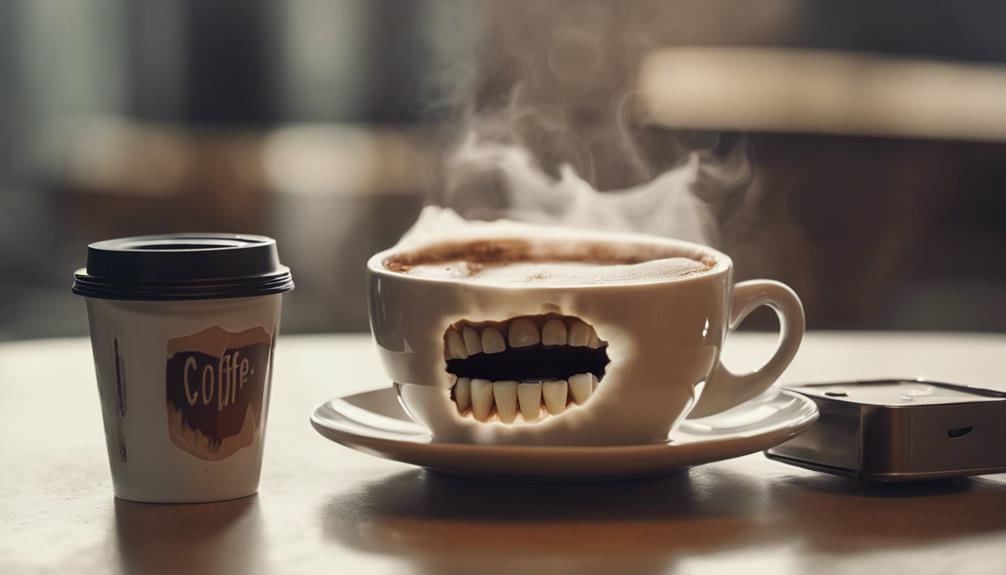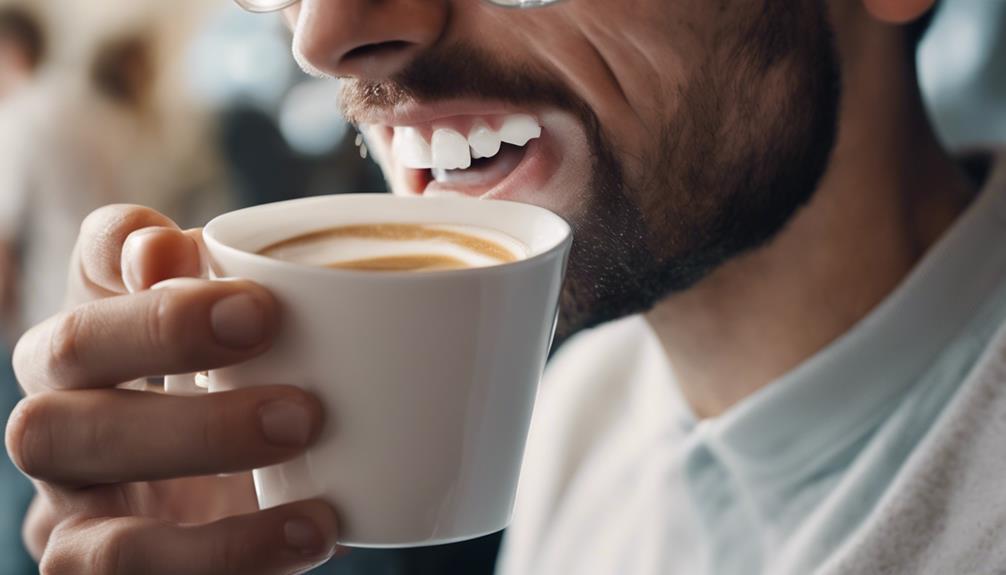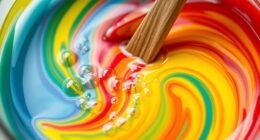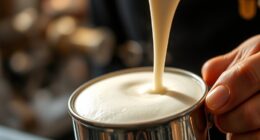As you get used to wearing a retainer, you may be wondering if your daily coffee habit is okay with your new oral hardware. The answer is not a simple yes or no. While coffee won’t instantly damage your retainer, the acidity and staining potential can have an impact on your teeth and retainer over time. Clear plastic retainers are more prone to staining, whereas metal components in Hawley retainers are more resistant. To reduce the risks, make sure to rinse your retainer with water after consuming coffee, limit sugary and acidic drinks, and prioritize oral hygiene. Keep exploring the compatibility of coffee and retainers to learn more about safe consumption practices.
Key Takeaways
• Drinking coffee with a retainer can lead to staining, enamel erosion, and tooth decay due to its acidity and chromogens.
• Hawley retainers with metal components are more resistant to staining, while clear plastic retainers are more susceptible to discoloration.
• Rinsing your retainer with water after drinking coffee can help minimize staining, and using a non-abrasive cleaner can prevent discoloration.
• Limiting coffee consumption and maintaining good oral hygiene can reduce the risks of oral health issues and retainer damage.
• Regular cleaning and maintenance of your retainer can prevent long-term discoloration and bacterial growth.
Coffee and Retainer Compatibility
When you wear a retainer, the dark pigmentation and acidity of coffee can be a recipe for disaster, potentially leading to unsightly stains and damage to your appliance. Drinking coffee while wearing a retainer can lead to enamel erosion and tooth discoloration.
The high acidity in coffee can erode the enamel on your teeth, causing discoloration and weakening your teeth. Additionally, the porous materials used in some retainers, such as acrylic, are more prone to coffee stains compared to non-porous materials like metal or wire retainers. This can lead to unsightly stains and damage to your retainer.
Research suggests that drinking coffee while wearing a retainer increases the risk of oral health issues. To prevent these issues, proper care is essential. This includes rinsing your retainer with water after drinking coffee and cleaning it regularly to prevent stains and damage.
Types of Retainers and Coffee

As you consider the type of retainer that's right for you, you'll want to think about how different materials interact with coffee.
Hawley retainers, with their metal components, may be more resistant to staining than clear plastic retainers, which can absorb coffee's acidic properties.
Understanding the strengths and weaknesses of each type will help you make an informed decision about your retainer choice.
Hawley Retainer Options
Your Hawley retainer options, comprising acrylic and wire components, interact with coffee in distinct ways that you should consider. As a coffee lover, you might wonder how your daily cup affects your retainer. Here's what you need to know:
Hawley retainers, made of acrylic and wire, are more prone to coffee staining due to the porous nature of acrylic material. This means that the acrylic components can absorb coffee pigments, leading to noticeable discoloration over time.
Here are three key points to keep in mind:
- Acrylic components are more prone to staining: Coffee can seep into the porous acrylic material, causing discoloration.
- Wire components are less likely to stain: The wire parts of your Hawley retainer are less susceptible to coffee staining.
- Proper care is essential: Rinsing your retainer after coffee consumption and regular cleaning can help maintain its appearance.
Considering alternative retainers like clear plastic or metal may be beneficial for coffee drinkers to minimize staining effects. By understanding how coffee interacts with your Hawley retainer, you can take proper care to maintain its appearance and functionality.
Clear Plastic Retainers
Clear plastic retainers, which you may be contemplating as an alternative to Hawley retainers, have a porous nature that makes them more susceptible to coffee staining. This means that coffee can seep into the material, leading to discoloration over time.
To guarantee this, it's advisable to remove your clear plastic retainer before drinking coffee. Regular cleaning and maintenance are essential to preserve the appearance and integrity of your retainer.
If you're a coffee lover, you may want to contemplate choosing non-porous retainer materials like metal or wire, which are less prone to staining. Keep in mind that clear plastic retainers require more upkeep to maintain their appearance.
By taking the necessary precautions, you can enjoy your daily cup of coffee while keeping your retainer in good condition. Remember, regular cleaning and maintenance are key to preventing discoloration and staining.
Coffee's Impact on Oral Health

Understanding the potential risks to your oral health is crucial as you sip your morning coffee while wearing your retainer.
However, it's important to grasp how coffee's staining power, acidic pH levels, and tooth decay risks can impact your teeth and retainer.
Caffeine's Staining Power
When you drink coffee while wearing a retainer, the dark pigmentation and high acidity in your coffee can silently wreak havoc on your oral health and the integrity of your retainer. The staining power of caffeine can lead to unsightly discoloration on your retainer, making it look worn out and unhygienic.
Additionally, the acidity in coffee can cause enamel erosion, tooth discoloration, and potential oral health issues when consumed with retainers.
Here are three key takeaways to keep in mind:
- Coffee's acidity erodes enamel: The high acidity in coffee can wear away the enamel on your teeth, making them more susceptible to decay and sensitivity.
- Tooth discoloration is a risk: The dark pigmentation in coffee can cause stains on your teeth, leading to an uneven and unsightly smile.
- Retainer damage is possible: The acidity and staining power of coffee can damage your retainer over time, affecting its appearance and integrity.
It's essential to be aware of these risks to take necessary precautions and maintain good oral health while wearing a retainer.
Tooth Decay Risks
Drinking coffee with a retainer significantly increases your risk of tooth decay, as the sugar in coffee and the retainer's tendency to trap bacteria create a perfect storm for cavities. This combination can lead to enamel erosion, making your teeth more susceptible to tooth decay risks.
Additionally, the dark pigmentation of coffee can cause staining, which can be difficult to remove, especially when wearing a retainer. Regular consumption of coffee with a retainer may result in oral health issues like cavities, staining, and potential damage to the retainer itself.
To mitigate these risks, it's essential to practice proper oral hygiene, including rinsing after coffee consumption and cleaning the retainer regularly. Removing the retainer before drinking coffee is also recommended to prevent staining, bacterial growth, and potential harm to both the retainer and your oral health.
Acidic Ph Levels
Coffee's high acidity levels can wreak havoc on your oral health, particularly when consumed with a retainer, leading to enamel erosion and tooth discoloration. As you drink coffee, the acidic pH levels can contribute to oral health issues such as enamel sensitivity and decay.
Here are three key points to keep in mind:
- Acidic pH levels: Coffee's acidity can erode your tooth enamel, making it more susceptible to sensitivity and decay.
- Enamel erosion risk: Regular consumption of coffee with retainers may increase the risk of staining and potential damage to oral health.
- Importance of oral hygiene: Rinsing thoroughly after drinking coffee and following proper cleaning routines can help minimize the negative effects of acidity on retainers.
Understanding the impact of coffee's acidity on retainers is crucial for maintaining oral hygiene and preserving the integrity of the appliances. By being aware of these risks, you can take steps to protect your oral health and ensure your retainers remain effective.
Safe Beverages for Retainer Wearers

As you navigate your daily routine with a retainer, you'll want to opt for beverages that won't compromise your orthodontic investment.
When it comes to drinking coffee or hot beverages like coffee, it's important to be mindful of the risk of staining. While you can still enjoy your favorite cup, it's vital to maintain oral hygiene and take preventative measures. Using retainer cleaning tablets can help mitigate the risk of staining, but it's still significant to be cautious.
Limiting sugary and acidic beverages can help prevent damage to both teeth and retainers. Water is the safest beverage option, as it won't stain or harm your retainers.
If you do choose to consume colored or sugary drinks, make sure to promptly rinse your mouth and clean your retainers afterward.
Coffee Consumption Precautions

When consuming coffee with your retainer in place, you're exposing your orthodontic device and teeth to the staining effects of dark pigmentation and acidity. This can lead to unwanted discoloration and potentially harm your oral health.
Here are three key points to keep in mind when enjoying coffee with your retainer:
- Staining and acidity: The dark pigmentation in coffee can stain your retainer and teeth, while the acidity can erode your tooth enamel, leading to oral health issues.
- Enamel erosion: The high acidity in coffee can potentially cause enamel erosion and tooth discoloration when consumed with retainers.
- Proper care: Rinsing thoroughly after drinking coffee and following proper cleaning routines for retainers can help minimize staining and oral health issues.
To minimize the risks, consider opting for higher quality, low-acid coffee options and prioritize proper care for your retainer and teeth. By being mindful of these precautions, you can enjoy your coffee while protecting your oral health.
Enjoying Coffee With Retainers Safely

You can enjoy your coffee while wearing a retainer safely by taking a few precautions to minimize the risks associated with staining and acidity. Since coffee can pose risks to your orthodontic treatment, it's important to be mindful of your consumption habits.
When you drink hot coffee, the high acidity can erode your teeth and discolor your retainer. However, you can still enjoy your favorite beverage by taking simple precautions. After drinking coffee, rinse your mouth thoroughly to remove any residue that could stain your retainer. Additionally, adopt a regular cleaning routine to prevent stains from building up.
Remember, different types of retainers interact differently with coffee, so it's vital to understand how coffee affects your specific retainer type. By being proactive and taking these precautions, you can enjoy your coffee while ensuring your retainer remains in good condition.
With a few simple habits, you can still enjoy your daily cup of coffee while undergoing orthodontic treatment.
Retainer Care After Coffee Consumption

To ensure your retainer remains in pristine condition, it's important to prioritize thorough cleaning and maintenance after consuming coffee. Drinking coffee while wearing a retainer can lead to staining and discoloration if not properly cleaned.
To prevent this, follow these essential steps:
- Rinse with water: Thoroughly rinse your retainer with water after drinking coffee to remove any residue.
- Use a non-abrasive cleaner: Consider using a non-abrasive retainer cleaner to prevent staining and maintain cleanliness.
- Regular maintenance: Regularly clean and maintain your retainer to prevent long-term discoloration and bacterial growth.
Frequently Asked Questions
Can You Drink While Wearing a Retainer?
You're wondering if you can drink while wearing a retainer. The answer is yes, but with caution.
While it's generally okay to drink water or clear beverages, you should avoid consuming dark or acidic drinks like coffee, tea, or soda, as they can stain or damage your retainer.
Remove your retainer before drinking these beverages and practice good cleaning habits to maintain its integrity.
Will Coffee Stain a Clear Retainer?
You might be surprised to learn that 60% of coffee drinkers consume coffee at least three times a day.
Now, about your clear retainer: yes, coffee can stain it. The pigments and acidity in coffee can seep into the porous material, causing noticeable discoloration over time.
To prevent this, maintain good oral hygiene and cleaning routines. If you're concerned, consider switching to non-porous retainer materials like metal or wire.
What Can You Not Do With a Retainer?
You shouldn't drink hot beverages like coffee while wearing a retainer, as it can cause staining, discoloration, and potential damage to the material. Additionally, the heat from the hot beverage can also weaken the structure of the retainer, leading to a higher risk of it becoming misshapen or even breaking. It’s important to prioritize the maintenance of your retainer by avoiding hot beverages and following any care instructions provided by your orthodontist. Ultimately, keeping your retainer in place and in good condition will help ensure the success of your orthodontic treatment.
Additionally, you should avoid consuming acidic drinks, as they can erode the retainer over time.
It's also essential to refrain from eating sticky or hard foods, as they can dislodge or break the retainer.
Is It OK to Sleep With Retainers?
You can safely sleep with your retainer in most cases, as advised by orthodontists. Wearing retainers during sleep helps maintain teeth alignment and prevents shifting.
However, some individuals may experience discomfort or have specific instructions from their orthodontist. It's important to consult with your orthodontist for personalized guidance on wearing retainers while sleeping, ensuring long-term orthodontic treatment success.
Conclusion
As you sip your coffee, keep in mind the importance of prioritizing your retainer's well-being, just like a master chef tends to a delicate soufflé.
By being mindful of the types of retainers and coffee, their impact on oral health, and taking precautions, you can enjoy your daily cup while keeping your retainer in top shape.
So, go ahead and savor that aromatic brew, but do it responsibly, and your retainer will thank you.









